Firth of Clyde: Difference between revisions
mNo edit summary |
|||
| Line 64: | Line 64: | ||
==Shipping in the Firth== | ==Shipping in the Firth== | ||
[[File:Clyde shipping.jpg|right|thumb|200px|Gourock and Kilcreggan]] | [[File:Clyde shipping.jpg|right|thumb|200px|Gourock and Kilcreggan]] | ||
[[File:Greenock esplanade.jpg|thumb|A ship unloads at Greenock's Ocean Terminal]] | [[File:Greenock esplanade.jpg|right|thumb|200px|A ship unloads at Greenock's Ocean Terminal]] | ||
The Firth of Clyde like the [[River Clyde]] has historically been an important centre of shipbuilding. There have been shipyards at [[Renfrew]], [[Greenock]], [[Port Glasgow]] and [[Troon]] and a major boatyard at [[Fairlie, Ayrshire|Fairlie]]. Ferguson Shipbuilders yard, adjacent to Newark Castle, [[Port Glasgow]], is one of the last privately owned shipyards left in Scotland. Port Glasgow is also the site of one of the world's largest dry dock and ship-repair facilities at Inchgreen. The dry dock there is 305m long and 44m wide and is operated by Northwestern Shiprepairers Limited using the name Scott Lithgow, although the company is unrelated to the famous Port Glasgow Scott Lithgow shipbuilding company. | The Firth of Clyde like the [[River Clyde]] has historically been an important centre of shipbuilding. There have been shipyards at [[Renfrew]], [[Greenock]], [[Port Glasgow]] and [[Troon]] and a major boatyard at [[Fairlie, Ayrshire|Fairlie]]. Ferguson Shipbuilders yard, adjacent to Newark Castle, [[Port Glasgow]], is one of the last privately owned shipyards left in Scotland. Port Glasgow is also the site of one of the world's largest dry dock and ship-repair facilities at Inchgreen. The dry dock there is 305m long and 44m wide and is operated by Northwestern Shiprepairers Limited using the name Scott Lithgow, although the company is unrelated to the famous Port Glasgow Scott Lithgow shipbuilding company. | ||
Revision as of 12:59, 13 April 2012
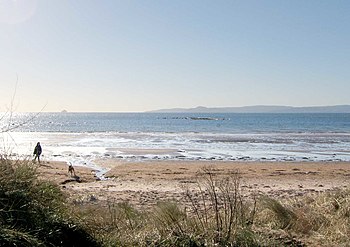
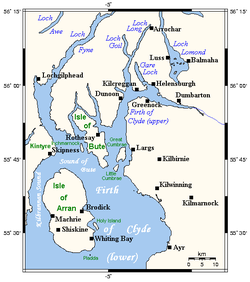
The Firth of Clyde forms a large area of coastal water, sheltered from the Atlantic Ocean by the Kintyre peninsula which encloses the outer firth between Argyllshire and Ayrshire. Within the firth are several pretty islands which constitute Buteshire. The Kilbrannan Sound is a large arm of the Firth of Clyde, separating the Kintyre peninsula from the Isle of Arran.
At its entrance, the firth is some 26 miles wide. Its upper reaches include an area where it is joined by Loch Long and the Gare Loch. This includes the large anchorage off Greenock known as the Tail of the Bank in reference to the sandbar which separates the firth from the estuary of the River Clyde itself. The Clyde is still almost 2 miles wide at the sandbar, and its upper tidal limit is at the tidal weir adjacent to Glasgow Green.
The cultural and geographical distinction between the firth and the River Clyde is vague as well it should be, for the folk of Dumbarton are happy to say they sit on the Firth of Clyde, while those of Port Glasgow and Greenock downstream will say they are on the river. As the waters of the Clyde has turned the corner at Dunoon, soon to open up, there can be no doubt that the Firth has been reached.
Geography
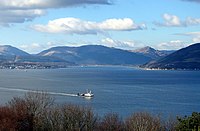
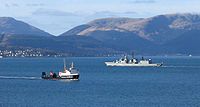
The firth encompasses many islands and peninsulas and has twelve Caledonian MacBrayne ferry routes connecting them to the mainland and each other. This busy water is sometimes called the "Clyde Sea". Many of the routes are lifeline services for communities living in remote areas.
The chief islands of the "Clyde Sea" constitute Buteshire, principal among them the Isle of Bute, the Isle of Arran, Great Cumbrae and Little Cumbrae. Remarkably, not a single ferry route runs from any one of these islands to one other.
A number of sea lochs adjoin the firth.
Islands in the Clyde

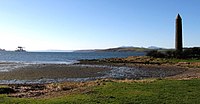
There are many islands in the firth, most belonging to Buteshire. The largest are all in Buteshire and all these have thriving communities and regular ferry services connecting them to the mainland. They are:
Sea lochs off the Clyde
- Gare Loch
- Loch Long, and Loch Goil
- Holy Loch
- Loch Striven
- Loch Riddon off the Kyles of Bute
- Loch Fyne, Loch Gilp and Loch Shira
- Loch Ranza
- Campbeltown Loch
Historical interest
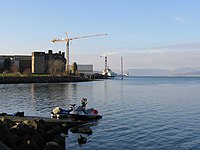
The Clyde formed an important sea route from the earliest times. Here at the Battle of Largs marked the end of Norwegian power in the islands.
The Union in 1707 brought the greatest change, for Glasgow could then trade with America and the West Indies; the first ships set out within weeks and soon the firth was filled with the ships which made Glasgow the greatest city in North Britain.
In the 19th century the "Clyde Puffers", steam boat coastal traders, began to ply between the islands. In the middle of the century the sport of yachting became popular on the Firth of Clyde. The area became famous worldwide for its very significant contribution to yachting and yachtbuilding and was the home of many notable designers: William Fife III; Alfred Mylne; G L Watson; David Boyd. It was also the location of many famous yacht yards. Clyde built wooden yachts, to this day, are well known for their quality and style.
In Victorian times with the advent of tourism the area became popular with Glaswegians who travelled 'doon the watter' on Clyde steamers to holiday in the picturesque seaside towns and villages that line the firth, with the more wealthy building substantial holiday homes along the coast. Many towns such as Largs, Dunoon and Rothesay flourished during this boom period and became fully fledged resorts with well-appointed hotels and attractions.
Nowadays the Waverley is that last paddle-steamer still makes trips to these coastal towns; a link to a gentler age.
In 1942, the World's first deep water test of a submarine oil pipeline was conducted on a pipeline laid across the Firth of Clyde in Operation Pluto. It was to prove vital to the supply of the Allied armies in the days following the D-Day landings in 1944.
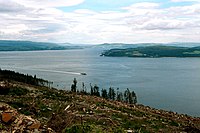
The "lower Clyde" shipyards of Greenock and Port Glasgow, most notably Scott Lithgow, played an important role in shipbuilding, with the Comet being the first successful steamboat in Europe, and a large proportion of the world's shipping being built there until well into the 20th century.
In more recent times the natural beauty of the firth has been marred in places by a succession of industrial and military developments along the shoreline, including Hunterston and Inverkip Power Stations, while at the same time shipbuilding has declined. Today only one lower Clyde shipyard survives, Ferguson Shipbuilders, next to Newark Castle, Port Glasgow, at the point where the firth becomes the River Clyde. The Garvel dry dock in Greenock continues in operation for ship repair, and the large Inchgreen dry dock in Port Glasgow is in occasional use. The sites of the former Greenock shipyards are currently being regenerated.
Marine wildlife
Common and Grey Seals abound in the firth. Harbour Porpoises are also common and while Dolphins are much less so, they have been spotted in the upper reaches of the firth in the summer of 2005. Whales do not favour the Clyde and although there have been instances of larger whales beaching themselves or becoming stranded in the upper firth, only smaller Pilot or Minke Whales seem to visit with any kind of regularity.
In 2005 the firth was listed as having the 2nd highest incidence of basking shark sightings in Scotland (after The Minch). In particular these huge sharks seem to favour the warm, shallow waters surrounding Pladda.
Although at one time heavily fished, the only catches remaining in Clyde waters today that are of any commercial interest to fisherman are prawns, lobster and herring.
There is a Marine Biological Station run by the Universities of Glasgow and London on Great Cumbrae.
Shipping in the Firth
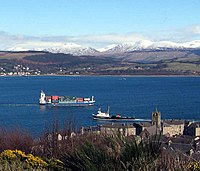
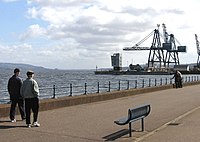
The Firth of Clyde like the River Clyde has historically been an important centre of shipbuilding. There have been shipyards at Renfrew, Greenock, Port Glasgow and Troon and a major boatyard at Fairlie. Ferguson Shipbuilders yard, adjacent to Newark Castle, Port Glasgow, is one of the last privately owned shipyards left in Scotland. Port Glasgow is also the site of one of the world's largest dry dock and ship-repair facilities at Inchgreen. The dry dock there is 305m long and 44m wide and is operated by Northwestern Shiprepairers Limited using the name Scott Lithgow, although the company is unrelated to the famous Port Glasgow Scott Lithgow shipbuilding company.
The Firth of Clyde has one of the deepest sea entrance channels in northern Europe, which can accommodate the largest Capesize vessels afloat, and as such the Clyde is one of the UK's leading ports, handling some 7.5 million tons of cargo each year, as well as regular cruise liner traffic at Greenock's Ocean Terminal facility.
In addition to the existing Hunterston bulk ore terminal, Clydeport, a £200m international deep-water container terminal is proposed, also at Hunterston, which would effectively act as a worldwide gateway port, and possibly become the major container port for the northern half of Europe. Initial environmental and economic impact studies are currently being undertaken.
The Royal Navy also has a significant presence on the Clyde, at HMNB Clyde on the Gare Loch and on Loch Long, while one of the three main ports providing marine services support vessels is at Greenock. This formerly came under the Royal Maritime Auxiliary Service which still operates some vessels, but the services have been put out to commercial tender by the Warship Support Agency and are currently operated by Serco Denholm, who are preferred bidders for the next contract.[1] The contract includes management of the ports at Devonport, Portsmouth and The Clyde (dual site operation at Faslane and Great Harbour, Greenock).
Lighthouses
There are lighthouses at:
- Cloch Point
- Toward Point
- Little Cumbrae
- Pladda
See also
References
- ↑ "1bn MoD Marine Services Contract". Serco. 6 February 2006. http://www.serco.com/media/pressreleases/2006/marineservices.asp. Retrieved 17 January 2011.